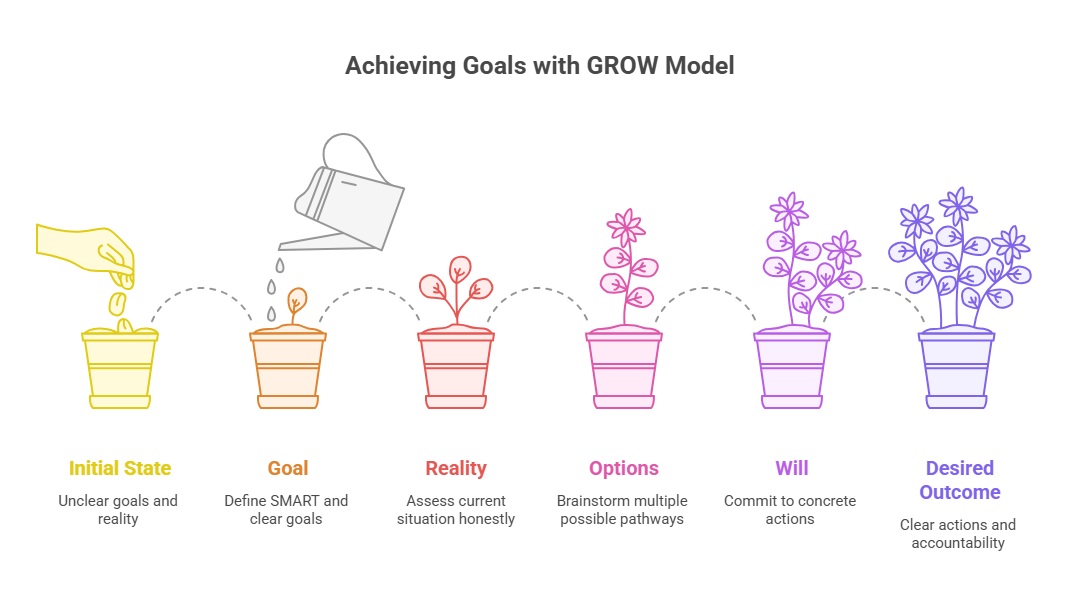Unlocking Potential with the GROW Coaching Model

 25 June,2025
Share
25 June,2025
Share
The modern workplace thrives on growth, adaptability, and self-leadership. Amidst rapidly evolving challenges, organizations are shifting from top-down management to more collaborative and empowering approaches. One of the most effective frameworks supporting this transformation is the GROW Coaching Model.
First introduced by Sir John Whitmore in the 1980s and popularized in his book Coaching for Performance, the GROW Coaching Model is a structured, yet flexible approach that fosters clarity, responsibility, and self-motivation. It stands for Goal, Reality, Options, and Will. This framework helps managers and teams develop actionable plans, overcome obstacles, and achieve both personal and organizational objectives.
Unlike traditional mentoring that often centers on advice-giving, the GROW Coaching Model emphasizes exploration through inquiry. It equips managers with the tools to help their team members uncover their own answers, thereby boosting autonomy and engagement.
In this article, we break down the framework in depth, explore its practical use, and demonstrate how organizations like Neuronimbus can help scale coaching for impactful growth.
Understanding the GROW Coaching Model Framework

The GROW Coaching Model offers a clear and structured pathway to foster meaningful conversations and develop practical solutions. Rooted in simplicity and effectiveness, this model encourages a coaching mindset grounded in curiosity, active listening, and self-discovery. Each step in the framework builds upon the last, guiding individuals and teams from goal-setting to committed action. Let’s explore how each element contributes to the power of the model.
1. Goal – Defining Success
The first step in the GROW Coaching Model is setting a clear, SMART goal. SMART stands for Specific, Measurable, Achievable, Realistic, and Time-bound. Defining a compelling goal raises the energy and focus of the coaching session.
2. Reality – Knowing Where You Stand
Before exploring solutions, both the coach and coached must understand the current situation. This involves honest assessment and reflection on what is working and what is not.
3. Options – Exploring Possibilities
Once the current reality is understood, the conversation turns to brainstorming. The aim is to generate multiple pathways toward the goal, including unconventional or previously considered ideas.
4. Will – Committing to Action
The final stage involves deciding what action the coached will take. This isn’t about what they could do, but what they will do – defining concrete steps, timelines, and accountability structures.
5. The Model’s Versatility
One of the reasons the GROW Coaching Model has become globally popular is its adaptability. It can be used in one-on-ones, performance reviews, team projects, and personal development plans.
Setting Effective Goals: The First Step in GROW

Setting goals is not just the beginning of the GROW process; it’s the foundation upon which everything else is built. Effective goals create direction, accountability, and a sense of purpose. When goals are meaningful and personalized, they ignite internal motivation and clarity. Within the GROW Coaching Model, this first step sets the tone for honest reflection and strategic planning that follows.
1. The Power of Specificity
General goals yield vague outcomes. A goal like “be a better communicator” lacks direction. Using the GROW Coaching Model, coaches help coachees refine their goals into something like “deliver monthly team updates with clear takeaways in under 10 minutes.”
2. Co-creating Goals
In collaborative settings, managers and employees should define goals together. This builds trust, mutual accountability, and ensures alignment with both individual and organizational visions.
3. Short-Term vs. Long-Term Goals
The model accommodates both immediate tasks and aspirational visions. A goal might be “complete a certification in 90 days” or “transition into a leadership role in two years.”
4. Visualizing Success
Questions like “What does success look like?” or “What will people say once you’ve achieved this?” help anchor the goal in the coachee’s imagination, making it more tangible and motivating.
5. Revisiting Goals for Relevance
As sessions progress, it’s crucial to revisit the goal. Has anything changed? Is the goal still aligned with the coachee’s priorities? The GROW Coaching Model encourages flexibility.
When revisiting goals, coaches should look for signs of shifting motivations or external changes that may impact feasibility. This step ensures that the goal remains inspiring, actionable, and connected to the broader vision. For example, a coach initially focused on team management might shift toward innovation or technical leadership over time.
It’s also beneficial to revisit earlier discussions and feedback. What has the coached person learned since the first session? Have they gained confidence, resources, or insights that now make a more ambitious version of their goal possible? Or do new challenges require recalibrating expectations?
Checking in on the emotional connection to the goal is equally important. If the coached person no longer feels excited about the goal, it might indicate a need to dig deeper and refine it into something more meaningful. In the GROW Coaching Model, progress is not always linear; looping back to the goal ensures continued relevance and momentum. As sessions progress, it’s crucial to revisit the goal. Has anything changed? Is the goal still aligned with the coached person’s priorities? The GROW Coaching Model encourages flexibility.
Ready to Turn Coaching into a Scalable Advantage?
Discover how Neuronimbus can help you implement the GROW Coaching Model with powerful digital tools, expert consulting, and custom solutions.
Let’s Talk →
Exploring Reality with Clarity and Curiosity
1. Getting Honest About the Present
Effective coaching begins with a clear-eyed view of the current situation. This step requires coachees to reflect without sugarcoating or exaggeration. It’s about grounding the conversation in facts, not assumptions. Without an honest understanding of what is actually happening, any future plan rests on shaky ground. Coaches help coachees unpack what’s real, helping them recognize patterns, gaps, and truths that are often overlooked or avoided.
2. Avoiding Storytelling Loops
It’s easy for coachees to get caught up in storytelling—reliving moments, justifying actions, or blaming others. While context matters, endless backstory can stall progress. Coaches redirect the narrative by asking targeted, present-focused questions like, “What have you already tried?” or “Who else is directly affected by this?” These prompts help the coachee detach from drama and instead focus on concrete facts and current dynamics that can be addressed.
3. Introducing New Perspectives
Reality is rarely one-dimensional. Coaches expand the coachee’s view by inviting other lenses: “What would your manager say about this?” or “How might a customer interpret the same situation?” These alternative viewpoints can surface blind spots, challenge assumptions, and broaden understanding. By stepping outside their own perspective, coachees often discover insights that shift their emotional response and improve decision-making.
4. Embracing Discomfort
Real growth often begins in discomfort. When coachees confront truths they’ve been avoiding—such as missed deadlines, inconsistent behavior, or strained relationships—it can be unsettling. But this discomfort isn’t a sign of failure; it’s a gateway to insight. Coaches create a safe, supportive space for these moments, reinforcing that discomfort is part of transformation and an essential ingredient in meaningful personal and professional change.
5. Tracking Progress Within Reality
As awareness deepens, the perception of “reality” may evolve. Coachees may start to see their situation differently once they’ve talked it through or acted on initial insights. The GROW Coaching Model encourages iterative reflection: revisiting earlier observations, adjusting assumptions, and refining next steps. It recognizes that reality is dynamic and coaching is a fluid process, not a fixed script. Ongoing check-ins help coachees stay grounded while adapting with purpose.
Identifying Options and Opportunities
1. Encouraging Open Brainstorming
This stage is about quantity, not perfection. The goal is to open up creative thinking and generate as many options as possible without immediate judgment. Coaches might ask, “What else could you do?” or “If anything were possible, what would you try?” These prompts expand imagination and reduce self-censorship. Even far-fetched ideas have value—they stretch thinking and can spark more grounded, actionable solutions through unexpected connections.
2. Avoiding Premature Judgments
Too often, coachees begin filtering ideas before they’ve explored them fully. They may label options as unrealistic or impractical before weighing their potential. A skilled coach pushes back on this impulse, encouraging exploration over evaluation. This phase is about discovery, not decision. Holding space for imperfect or incomplete ideas gives coachees room to innovate and often leads to more authentic, personalized solutions than if they filtered too early.
3. Leveraging Experience
Past wins and failures are valuable resources. Coaches prompt coachees to ask, “What’s worked before in similar situations?” or “Where have I seen someone solve a similar challenge?” Drawing from personal history or observed examples adds depth and realism to the brainstorm. It reminds coachees they’re not starting from scratch and can build on proven tactics, increasing both their confidence and their ability to act effectively.
4. Tapping into External Resources
Sometimes, the best ideas come from outside the immediate environment. Coaches help coachees think beyond themselves—suggesting they consult mentors, explore relevant training, or get feedback from trusted peers. External input can offer fresh strategies, unlock networks, and accelerate progress. Identifying where help already exists shifts the mindset from isolation to empowerment, reinforcing that asking for support is a strength, not a weakness.
5. Balancing Innovation with Feasibility
While creativity is essential, not every idea is meant to be implemented. Coaches help coachees strike a balance between big thinking and practical execution. This involves gently steering the conversation toward options that are both exciting and doable. The GROW Model doesn’t shut down bold ideas—but it does ensure that plans are rooted in context, resources, and relevance. This balance increases follow-through and drives meaningful, realistic progress.
Establishing Will and Committing to Action
1. Narrowing Down the Options
After exploring multiple possibilities, it’s time to focus and choose a concrete path forward. This is where commitment begins. The coach helps the coachee evaluate which option feels most realistic, aligned, and achievable. The central question becomes: “What will you do now?” It shifts the conversation from brainstorming to decision-making, turning broad ideas into focused intent. Without this transition, even great insights can stall out without ever becoming action.
2. Ensuring Personal Ownership
Ownership is the engine behind follow-through. If a coachee doesn’t feel truly responsible for their next steps, motivation quickly fades. Coaches ask direct questions like “How committed are you to this?” or “What might prevent you from following through?” These prompts encourage reflection and help surface internal hesitations. When the commitment is self-driven—not imposed—the likelihood of success rises. It’s about shifting from external accountability to internal drive.
3. Creating Specific Plans
Intent without structure rarely leads to results. That’s why clear, actionable plans are essential. Coaches guide coachees in defining the “what,” “when,” and “how” of their actions. This includes setting deadlines, identifying needed resources, and clarifying who or what will provide accountability. The more specific the plan, the more likely it is to be executed. Vague intentions lead to ambiguity, while concrete steps create momentum and measurable progress.
4. Recognizing Motivation Gaps
A lack of energy or enthusiasm often signals an underlying issue with the plan. Coaches must tune in to nonverbal cues and hesitation in language. If motivation is low, it may mean the chosen action doesn’t align with the coachee’s real goals or values. In these cases, it’s wise to revisit earlier stages of the GROW Model. Better to refine the direction than to move forward with a plan destined to fizzle out.
5. Reaffirming the Why
Clarity of purpose is a powerful motivator. As the coachee moves toward action, reconnecting with their original goal can strengthen resolve. Coaches remind them why the goal matters; what impact it will have, and how it connects to their bigger picture. This emotional anchor fuels persistence, especially when challenges arise. Reaffirming the “why” isn’t just about inspiration; it’s a practical tool for maintaining focus and driving sustained commitment to follow-through.
Here’s a revised version of Section 7 that integrates the specific services Neuronimbus provides; structured training, tailored coaching solutions, digital tools, data-driven insights, and ongoing support – while keeping the message focused and impactful:
How Can Neuronimbus Help?
Neuronimbus empowers organizations to embed the GROW Coaching Model by combining strategic consulting, cutting-edge technology, and user-focused design. Our approach starts with innovation consulting and digital strategy to align coaching objectives with your broader transformation goals. To operationalize the GROW framework, we design custom digital solutions; from SaaS applications to enterprise and mobile platforms, that let managers and teams track goals, log coaching sessions, and measure outcomes in real time. Through UI/UX design services, including user research, usability testing, and CX design, we ensure these tools are intuitive and engaging, driving higher adoption among your workforce. Our data architecture and cloud engineering services support the back end, enabling secure, scalable storage and analytics that help you combine coaching insights with performance data. This fusion of emotional intelligence and analytics enhances the impact of every coaching conversation.
For organizations looking to move fast, we offer prototyping and MVP development, so your teams can start using and refining tools early. We also provide quality assurance, application maintenance, and ongoing support to make coaching a lasting, evolving capability. Whether it’s through business process optimization, software re-engineering, or digital experience design, Neuronimbus helps you not just adopt the GROW Coaching Model—but build a coaching ecosystem that scales, sustains, and transforms your organization from the inside out.
Categories
Quick Contact
LET'S REINVENT TALENT MANAGEMENT
Contact us to book a demo and see how NeuroTal can help your organisation.

© 2024-25. Neuronimbus Digital Pty Ltd. All Rights Reserved.


